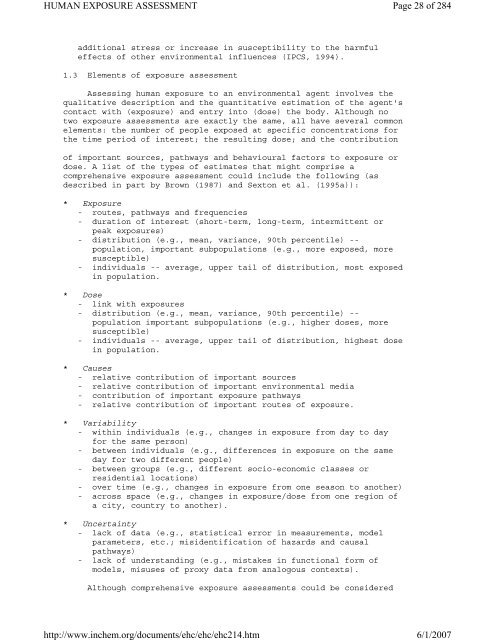Environmental Health Criteria 214
Environmental Health Criteria 214
Environmental Health Criteria 214
Create successful ePaper yourself
Turn your PDF publications into a flip-book with our unique Google optimized e-Paper software.
HUMAN EXPOSURE ASSESSMENT<br />
additional stress or increase in susceptibility to the harmful<br />
effects of other environmental influences (IPCS, 1994).<br />
1.3 Elements of exposure assessment<br />
Assessing human exposure to an environmental agent involves the<br />
qualitative description and the quantitative estimation of the agent's<br />
contact with (exposure) and entry into (dose) the body. Although no<br />
two exposure assessments are exactly the same, all have several common<br />
elements: the number of people exposed at specific concentrations for<br />
the time period of interest; the resulting dose; and the contribution<br />
of important sources, pathways and behavioural factors to exposure or<br />
dose. A list of the types of estimates that might comprise a<br />
comprehensive exposure assessment could include the following (as<br />
described in part by Brown (1987) and Sexton et al. (1995a)):<br />
* Exposure<br />
- routes, pathways and frequencies<br />
- duration of interest (short-term, long-term, intermittent or<br />
peak exposures)<br />
- distribution (e.g., mean, variance, 90th percentile) --<br />
population, important subpopulations (e.g., more exposed, more<br />
susceptible)<br />
- individuals -- average, upper tail of distribution, most exposed<br />
in population.<br />
* Dose<br />
- link with exposures<br />
- distribution (e.g., mean, variance, 90th percentile) --<br />
population important subpopulations (e.g., higher doses, more<br />
susceptible)<br />
- individuals -- average, upper tail of distribution, highest dose<br />
in population.<br />
* Causes<br />
- relative contribution of important sources<br />
- relative contribution of important environmental media<br />
- contribution of important exposure pathways<br />
- relative contribution of important routes of exposure.<br />
* Variability<br />
- within individuals (e.g., changes in exposure from day to day<br />
for the same person)<br />
- between individuals (e.g., differences in exposure on the same<br />
day for two different people)<br />
- between groups (e.g., different socio-economic classes or<br />
residential locations)<br />
- over time (e.g., changes in exposure from one season to another)<br />
- across space (e.g., changes in exposure/dose from one region of<br />
a city, country to another).<br />
* Uncertainty<br />
- lack of data (e.g., statistical error in measurements, model<br />
parameters, etc.; misidentification of hazards and causal<br />
pathways)<br />
- lack of understanding (e.g., mistakes in functional form of<br />
models, misuses of proxy data from analogous contexts).<br />
Although comprehensive exposure assessments could be considered<br />
http://www.inchem.org/documents/ehc/ehc/ehc<strong>214</strong>.htm<br />
Page 28 of 284<br />
6/1/2007

















